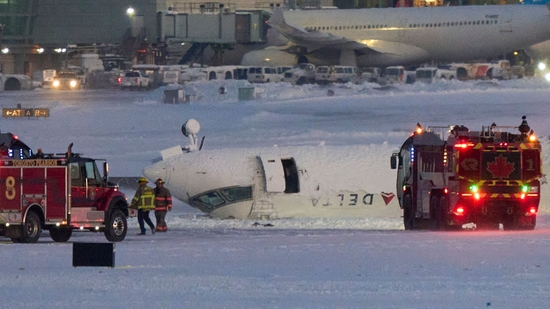The plane hit the runway at a 50% greater descent velocity than the rate its landing gear was designed to absorb, according to a preliminary report from the TSB, an independent transportation safety agency
A safety warning system went off in a Delta Air Lines regional jet, signaling a fast descent before it landed and flipped over at Canada’s largest airport in February, the country’s Transportation Safety Board said on Thursday.
Despite nearly two dozen injured passengers, none of the 80 people died on board flight DL4819, a CRJ900 jet operated by Delta’s Endeavor Air subsidiary from Minneapolis-St. Paul International Airport.
The plane hit the runway at a 50% greater descent velocity than the rate its landing gear was designed to absorb, according to a preliminary report from the TSB, an independent transportation safety agency.
The sink rate warning came on less than three seconds before touchdown, said TSB investigator Ken Webster who is handling the probe.
U.S. aviation safety expert John Cox said the flight was proceeding normally until it approached Toronto’s Pearson Airport, when the plane hit a gust of wind at about 153 feet. In response, the first officer, who had 1,422 hours of total flight time and 419 hours on the CRJ, correctly reduced the power, said Cox, who is also a pilot.
At about four seconds before touchdown the gust ended leading the airspeed to fall off, but the pilots never increased the power or pitch, he said.
“It’s a bad feeling as a pilot. You can feel the airplane start to come out from under you. It’s miserable,” Cox added. “And you have to take action in a hurry to get that sorted out. They did not.”
Cox said it wasn’t clear why the captain, who had worked for Endeavor Air since 2007 and had 3,570 hours of total flight time, didn’t increase power or take other steps to counter the rate at which the plane was sinking toward the ground.
According to the report, the landing gear is designed for a descent of 12 feet per second but the plane was descending at over 18 feet per second when it touched down.
The reported weather conditions at time of the crash indicated a “gusting crosswind and blowing snow,” according to the site FlightRadar24.
“It’s trying conditions weather wise, but nothing that a professional pilot should not be able to handle,” Cox said.
Delta declined comment on the preliminary report, which does not give causes. Under international rules for air crash investigations, a final, more comprehensive report is expected about a year after the incident.
Webster said the TSB would detail why it happened in the final report.
Reuters

